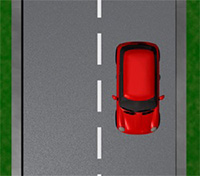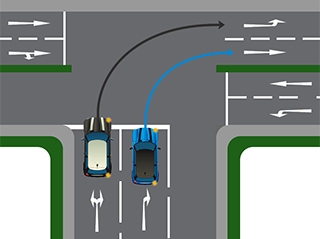Road Position & Lane Discipline
Where you position your car on the road is dictated by the road and traffic conditions you are experiencing. On your driving test you will need to keep a safe position at all times.
In normal circumstances you should position your car in the centre of your half of the road – see image below.

You should avoid driving too close to the kerb, as the road surface here is more uneven. If you accidentally clip the kerb you may lose control of the car. However, you may need to move closer to the kerb to:
- make space for oncoming traffic through a narrow gap
- let another vehicle overtake you
- let a motorcycle pass in congested traffic
- increase your vision & safety when approaching a right-hand bend
You will need to move to the right of your lane when:
- making a right-hand turn
- the pavement is busy with pedestrians
- when overtaking a cycle or other road user.
When passing parked vehicles, if possible you should leave enough room for a car door to open without you hitting it, about a metre. When passing a row of parked cars don’t weave in and out between them. You should maintain a steady, straight course. When changing lanes or road position you must:
- use the MSM/PSL routine
- plan ahead and make sure you move into the correct lane in good time
- use signals if necessary
One-Way Roads
When you enter a one-way street you should position your car according to whether you intend to go ahead, turn left or turn right.
- When turing left, keep to the left-hand lane
- When turning right, keep to the right-hand lane
- When going straight ahead let the road markings guide you. If there are no lane markings then you will usually need to select the left-hand lane.
Lane Discipline
Always keep within the road markings indicating your lane unless you are changing lanes or direction.
When changing lanes:
- look well ahead and try to anticipate early your need to change lanes
- use the MSM/PSL routine
- signal in good time
- when safe to do so move into the lane
You must never:
- weave from lane to lane
- straddle two lanes
- change lanes suddenly
Lane markings inform and guide traffic. When approaching a junction you should look out for relevant road markings and respond to them as needed.
Lane Discipline At Junctions
- turn left – keep to the left-hand lane
- follow the road ahead – keep to the left-hand lane
- turn right – move to the right-hand lane in good time.
- turn left – keep to the left-hand lane
- follow the road ahead – keep to the left-hand or middle lane
- turn right – move to the right-hand lane in good time.

Two-Lane Junctions
Where there are two or more lanes marked for the direction you wish to take, (see the image on the right-hand side) choose the most convenient one. To do this you need to know where you should be positioned at the next junction.
If you don’t know which lane you need to take, road signs and lane markings leading to the junction should be able to give you the correct guidance.
Unless you need the right lane at the next junction it is normally better to select the left lane. This will avoid you having to change lanes after you turn. If you select the right-hand lane for the turn, check carefully to the left after the turn to make sure there is no one in your blind area before returning to the left lane.
Changing Lanes in heavy Traffic
Look and plan well ahead, reading the signs and markings. This will help you get into the correct lane in good time. If you do find yourself in the wrong lane in heavy traffic, avoid trying to change lanes quickly.
Use MSPSL and try to make eye contact with a driver already in the lane you wish to move into. When you are sure the other driver is letting you in, move over gradually and acknowledge the driver who let you move in.
Before you move, however, check your side mirrors for cyclists and motorcyclists driving between the lanes.
Road Position When Stationary
When stationary, such as when stuck in a traffic jam, use the ‘Tyres and Tarmac’ rule:
Always stop far enough behind the vehicle in front that you can see their tyres touching the the road and 1 metre of tarmac.
This space leaves room for you to comfortably pull out and pass should the vehicle in front break down. It also leaves you room to move out of the way if an emergency vehicle needs to pass.
Other rules you must observe:
- Never stop so that you block access to a side road or business entrance.
- If you stop alongside a parked car, allow room for the driver to open their door.
- When in a traffic jam, never stop on a pedestrian crossing.
- When you park, never block access to driveways or side roads.
- Do not park opposite bus stops unless there is plenty of room for vehicles to pass between you and a bus waiting at the stop.
- Never park too close to a vehicle displaying a disabled badge – the occupants may need room to put a wheelchair in the boot.
